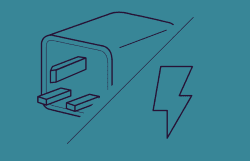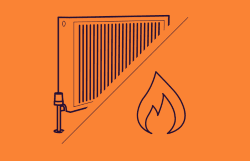Checking your gas bill and ensuring that your supplier isn’t overcharging you is an important thing to do. Our gas calculator makes checking all your bills quick and easy.
Your gas meter could be imperial and provide data in hundreds of cubic feet or metric and provide data in cubic metres. It should show on the display if it is in m3 (metric) or ft (imperial). Older meters tend to be imperial, new and smart meters are metric.
| Imperial (cubic feet) | Metric (cubic meters) |
|---|---|
| 1 cubic foot | 0.0283 cubic metres |
| 100 cubic feet | 2.83 cubic metres |
| 35.33 cubic feet | 1 cubic meter |

1 Unit (the first number with a black border) is one cubic metre on a metric meter.
1 Unit (the first white number) is 100 cubic feet on an imperial meter.
Taking Readings
Your gas supplier should take regular readings of your meter, but this doesn’t always happen. If your supplier is unable to do this for any reason, we recommend that you take the reading yourself and provide it to the supplier.
Submitting your own reading may avoid the potential inconvenience of receiving an estimated bill, or building up an unnecessary credit with your supplier.
The numbers on a gas meter are always read left to right. You can ignore any digit shown in red. It is a good idea to include any ‘zero’s’ in the reading provided to the supplier; thus in the following examples:

Readings are taken then converted to kilowatt hours (kWh) for billing purposes. If you have your meter readings to hand, enter your data into the gas bill calculator below to estimate your next bill.
Imperial Meters (ft³)
Metric Meters (m³)
Working out consumption manually
While the calculator makes it easy to check, we think it’s important to understand how the calculations actually work. So here is a complete guide to calculating the figures manually.
Step 1
Subtract your previous reading from your current reading to give the number of units used over the period. Most suppliers bill monthly, but some quarterly – you may want to track your consumption more regularly.
Step 2
The conversion factor from cubic feet to cubic metres is 0.0283 therefore:
- 1 cubic foot = 0.0283 cubic metres
- 100 cubic feet = 2.83 cubic metres
For imperial meters the reading (in hundreds of cubic feet) is multiplied by 2.83 to convert to cubic metres (if the reading is in cubic feet then this should be multiplied by 0.0283). This step is not required for metric meters as they are read directly in cubic metres.
Step 3
This number is then multiplied by the calorific value of the gas, which is a measure of the available heat energy. Calorific values vary and the figure quoted on your bill (eg 39.5 megajoules per cubic metre (MJ/m³)) will be an average of the gas supplied to your property (the regulations explain how this is calculated). Gas transporters must maintain this figure within 38 MJ/m³ to 41 MJ/m³ as figures outside of this range will cause problems with gas burning appliances.
Step 4
The figure is then multiplied by 1.02264 as prescribed in the above regulations. This figure corrects the volume of gas to account for temperature and pressure (as the gas expands and contracts).
Step 5
Finally, the figure is converted to kWh by dividing by 3.6. Again, this factor is prescribed in the above regulations.
Step 6
The number of kWh is then be multiplied by the price per kilowatt hour as detailed on your gas bill. You may also have a standing charge or one price for the first ‘X’ number of units and a lower price for the remaining units.
Glossary
Multiplier – The Multiplier factor converts imperial to metric. 2.83 hundred feet equals one metre.
The Conversion factor – The Conversion factor is an industry figure to account for atmospheric pressure. This figure varies over time, but it is the same for all suppliers.
The Calorific value – The Calorific value is the amount of heat produced when the gas is burned. This value adjusts for changes in the composition of gas when burned. The calorific value varies over time, and between different suppliers. It is always between 38 MJ/m³ to 41 MJ/m³, and is typically 39.5
The kWh conversion – The kWh conversion is a constant of 3.6. This is because 1-kilowatt hour is equivalent to 3.6 million joules.
Imperial meters – Imperial gas meters measured usage in cubic feet and were generally fitted before 2000.
Metric meters – Metric gas meters were introduced in 2000, and have replaced many older imperial meters.
Smart Meters – Smart meters can be fitted to, or replace metric meters. They measure the usage in metres and frequently have an option to display the usage in kWh.
What is 1 kWh
- The small burner on your gas hob (typically 1.1 to 1.3 kW output) will use approx. 1kWh to 1.5 kWh in one hour.
- A domestic gas fire will use approx. 2kWh in one hour when operating at maximum output.
- It would take approx. 9.2 kWh of gas to heat a 120 litre hot water tank by 60 degrees Celsius (based on approx. 90% boiler efficiency).




